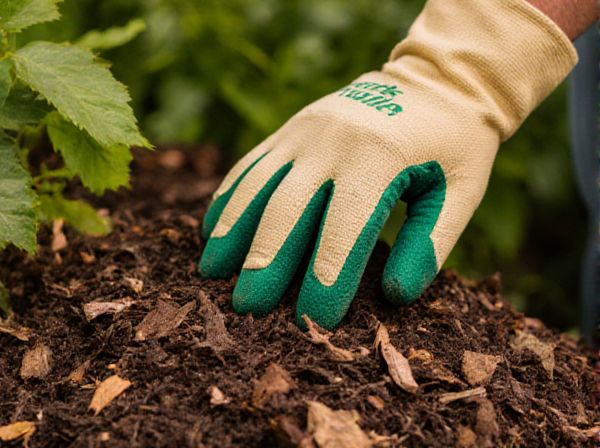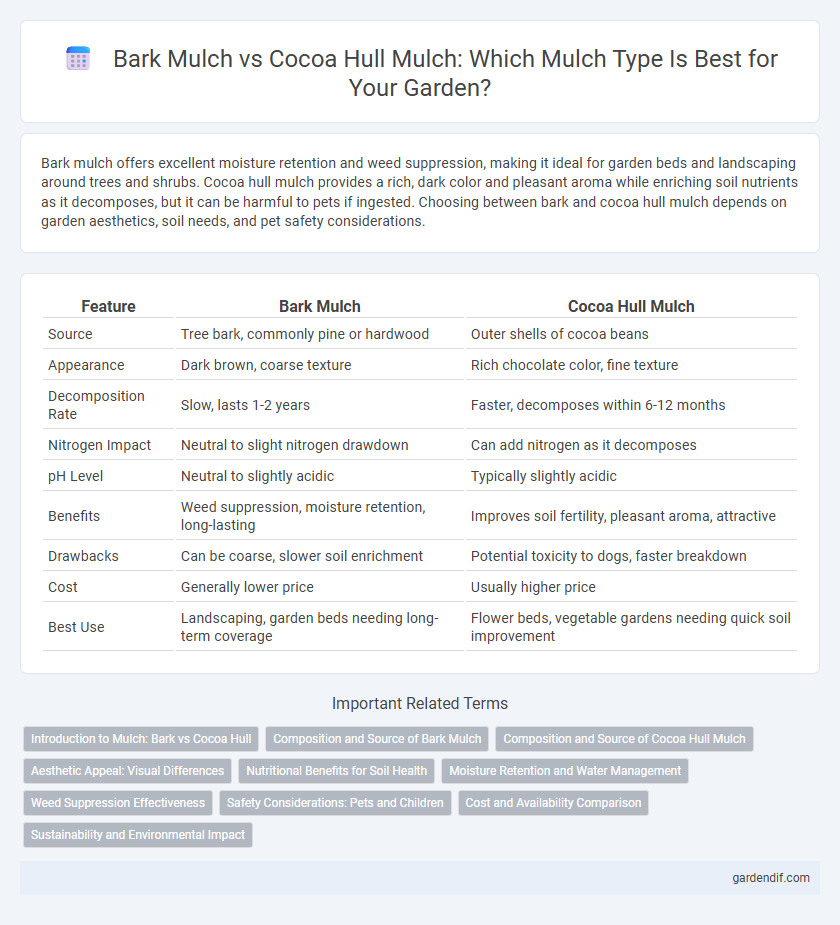
Bark Mulch vs Cocoa Hull Mulch Illustration
Bark mulch offers excellent moisture retention and weed suppression, making it ideal for garden beds and landscaping around trees and shrubs. Cocoa hull mulch provides a rich, dark color and pleasant aroma while enriching soil nutrients as it decomposes, but it can be harmful to pets if ingested. Choosing between bark and cocoa hull mulch depends on garden aesthetics, soil needs, and pet safety considerations.
Table of Comparison
| Feature | Bark Mulch | Cocoa Hull Mulch |
|---|---|---|
| Source | Tree bark, commonly pine or hardwood | Outer shells of cocoa beans |
| Appearance | Dark brown, coarse texture | Rich chocolate color, fine texture |
| Decomposition Rate | Slow, lasts 1-2 years | Faster, decomposes within 6-12 months |
| Nitrogen Impact | Neutral to slight nitrogen drawdown | Can add nitrogen as it decomposes |
| pH Level | Neutral to slightly acidic | Typically slightly acidic |
| Benefits | Weed suppression, moisture retention, long-lasting | Improves soil fertility, pleasant aroma, attractive |
| Drawbacks | Can be coarse, slower soil enrichment | Potential toxicity to dogs, faster breakdown |
| Cost | Generally lower price | Usually higher price |
| Best Use | Landscaping, garden beds needing long-term coverage | Flower beds, vegetable gardens needing quick soil improvement |
Introduction to Mulch: Bark vs Cocoa Hull
Bark mulch, derived from tree bark, is a traditional choice known for its durability, slow decomposition, and ability to suppress weeds effectively in landscaping. Cocoa hull mulch, made from the outer shells of cocoa beans, offers a rich color, pleasant aroma, and nutrient content beneficial for soil health but can be more attractive to pets, posing potential risks. Comparing these mulch types highlights differences in longevity, aesthetics, and safety considerations important for garden and landscape applications.
Composition and Source of Bark Mulch
Bark mulch is primarily composed of shredded or ground bark harvested from various tree species such as pine, cedar, or hardwoods, making it a natural and renewable resource. This mulch is typically sourced from the outer protective layer of trees, which is often a byproduct of the lumber industry, ensuring sustainable use of wood materials. Its coarse texture and slow decomposition rate contribute to long-lasting soil moisture retention and weed suppression compared to finer mulches like cocoa hulls.
Composition and Source of Cocoa Hull Mulch
Cocoa hull mulch is made from the outer shells of cocoa beans, a byproduct of the chocolate industry, rich in natural fats that help retain moisture and improve soil texture. Bark mulch primarily consists of shredded tree bark, usually from pine, cedar, or hardwood trees, providing a slower breakdown rate that enhances long-term soil protection. The organic compounds in cocoa hull mulch offer mild fertilizing benefits, whereas bark mulch is valued mostly for its durability and weed suppression capabilities.
Aesthetic Appeal: Visual Differences
Bark mulch offers a rustic, natural look with its coarse texture and deep brown tones, seamlessly blending into garden landscapes. In contrast, cocoa hull mulch provides a richer, chocolate-brown color and a finer, smoother texture that enhances ornamental plant beds with a polished, decorative appearance. The visual contrast between these mulches affects the overall aesthetic by influencing color vibrancy and soil coverage uniformity in garden design.
Nutritional Benefits for Soil Health
Bark mulch enriches soil by slowly releasing organic matter, improving moisture retention and promoting beneficial microbial activity for long-term soil vitality. Cocoa hull mulch offers higher nitrogen content, enhancing nutrient availability and accelerating decomposition to boost soil fertility. Both mulches support soil health, but cocoa hull mulch provides more immediate nutritional benefits due to its rich organic nutrient profile.
Moisture Retention and Water Management
Bark mulch excels in moisture retention due to its coarse texture, allowing water to penetrate deeply while preventing rapid evaporation, making it ideal for water-efficient gardening. Cocoa hull mulch offers superior water management by maintaining consistent soil moisture levels and improving aeration, benefiting plant roots and reducing water runoff. Both materials enhance soil hydration, but bark mulch is preferable for long-term moisture conservation, whereas cocoa hull mulch supports balanced moisture distribution.
Weed Suppression Effectiveness
Bark mulch provides dense coverage that effectively blocks sunlight, significantly reducing weed growth by preventing seed germination. Cocoa hull mulch also suppresses weeds but tends to be less effective in heavy weed pressure due to its lighter texture and faster decomposition rate. Both mulches improve soil moisture retention, but bark mulch offers longer-lasting weed control, making it preferable for sustained suppression.
Safety Considerations: Pets and Children
Bark mulch, made from shredded tree bark, is generally safe for pets and children but may harbor insects or mold if not properly maintained. Cocoa hull mulch contains theobromine, a substance toxic to dogs and cats, making it a higher risk for households with pets. Choosing pet- and child-safe mulch requires careful assessment of materials to prevent accidental ingestion and related health hazards.
Cost and Availability Comparison
Bark mulch generally costs between $20 to $60 per cubic yard, making it a budget-friendly option widely available at garden centers and home improvement stores. Cocoa hull mulch, priced higher at $40 to $80 per cubic yard, is less commonly stocked due to its specialty nature and seasonal availability. The cost difference and local supply variations often influence homeowners' choice between the two mulches for landscaping projects.
Sustainability and Environmental Impact
Bark mulch, derived from tree bark, offers a highly sustainable option due to its natural decomposition process that enriches soil health without introducing toxins. Cocoa hull mulch, while biodegradable and rich in nutrients, carries potential environmental risks such as toxicity to pets and the carbon footprint associated with cocoa production. Choosing bark mulch generally supports lower ecological impact and promotes longer-lasting soil moisture retention and weed control.
Bark Mulch vs Cocoa Hull Mulch Infographic

 gardendif.com
gardendif.com